Ireland, the land of rolling green hills, ancient castles, and vibrant culture, beckons travelers from around the globe. Planning a trip to the Emerald Isle can be exciting, but knowing what to expect is crucial for a seamless and unforgettable experience. TRAVELS.EDU.VN is here to guide you through everything you need to know before embarking on your Irish adventure, ensuring you’re well-prepared to embrace the magic of Ireland. Discover essential travel tips, cultural insights, and practical advice for an incredible journey.
1. Understanding Ireland’s Weather and Packing Essentials
Ireland’s weather is famously unpredictable, often experiencing all four seasons in a single day. This is due to its location in the path of the North Atlantic Current, which brings mild, moist air.
- Expect the Unexpected: Be prepared for sudden changes in weather, from sunshine to rain showers. According to Met Éireann, the national meteorological service, rainfall is common throughout the year, with the highest amounts occurring in the west.
- Layering is Key: Pack versatile clothing that can be layered. A typical outfit might include a t-shirt, fleece jacket, waterproof outer layer, and comfortable trousers or jeans.
- Essential Gear: A waterproof jacket and umbrella are essential items. Sturdy walking shoes are recommended, especially if you plan on exploring the countryside.
- Don’t Forget: Sunglasses and sunscreen may seem unnecessary, but they can be useful on bright, sunny days.
 Windswept hair at the Cliffs of Moher showcasing the unpredictable Irish weather
Windswept hair at the Cliffs of Moher showcasing the unpredictable Irish weather
2. Navigating the Island: Republic of Ireland vs. Northern Ireland
The island of Ireland comprises two distinct entities: the Republic of Ireland and Northern Ireland. Understanding the difference is crucial for planning your itinerary and managing currency.
- Republic of Ireland: An independent country, also known as Ireland, is part of the European Union. Its capital is Dublin, and the official currency is the Euro (€).
- Northern Ireland: Part of the United Kingdom, located in the northeastern part of the island. Its capital is Belfast, and the official currency is the Pound Sterling (£).
- Border Crossing: When traveling between the Republic of Ireland and Northern Ireland, you are crossing an international border. While there are generally no formal border checks, it’s essential to be aware of the differing laws and regulations.
- Currency Considerations: Be prepared to exchange currency if you plan to travel between the two regions. Credit cards are widely accepted in both countries.
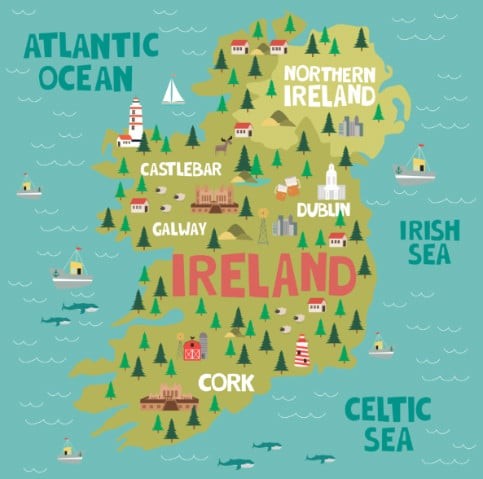 Map highlighting the geographical distinction between Northern Ireland and the Republic of Ireland
Map highlighting the geographical distinction between Northern Ireland and the Republic of Ireland
3. Currency Matters: Euros and Pounds Sterling
As previously mentioned, the Republic of Ireland uses the Euro (€), while Northern Ireland uses the Pound Sterling (£). This means you’ll need to manage your finances accordingly when traveling between the two regions.
- Currency Exchange: Currency exchange services are available at airports, banks, and bureaux de change. It’s advisable to compare exchange rates to get the best deal.
- ATM Availability: ATMs are widely available in both countries, making it easy to withdraw cash as needed. Check with your bank about international transaction fees.
- Credit Card Usage: Credit cards are widely accepted in most establishments, including hotels, restaurants, and shops. However, it’s always a good idea to carry some cash for smaller purchases and in rural areas.
- Budgeting Tip: Consider using a travel credit card with no foreign transaction fees to save money on purchases.
4. Exploring Ireland by Car: Freedom and Flexibility
Renting a car in Ireland offers unparalleled freedom and flexibility to explore the country’s stunning landscapes and hidden gems. While public transportation is available, a car allows you to venture off the beaten path and discover the true beauty of the Emerald Isle.
- Rental Car Options: Numerous car rental companies operate in Ireland, offering a wide range of vehicles to suit different needs and budgets. Consider booking in advance, especially during peak season. TRAVELS.EDU.VN can help you find the best deals on rental cars.
- Driving Conditions: Ireland’s roads are generally well-maintained, but some rural roads can be narrow and winding. Be prepared for varying road conditions and drive defensively.
- The Left Side of the Road: Remember that in Ireland, you drive on the left side of the road. This can take some getting used to, especially if you’re from a country where you drive on the right.
- Scenic Routes: Ireland boasts numerous scenic driving routes, such as the Wild Atlantic Way and the Ring of Kerry. These routes offer breathtaking views of the coastline and countryside.
- Parking: Parking can be limited and expensive in cities like Dublin. Consider using park-and-ride facilities or public transportation to avoid parking hassles.
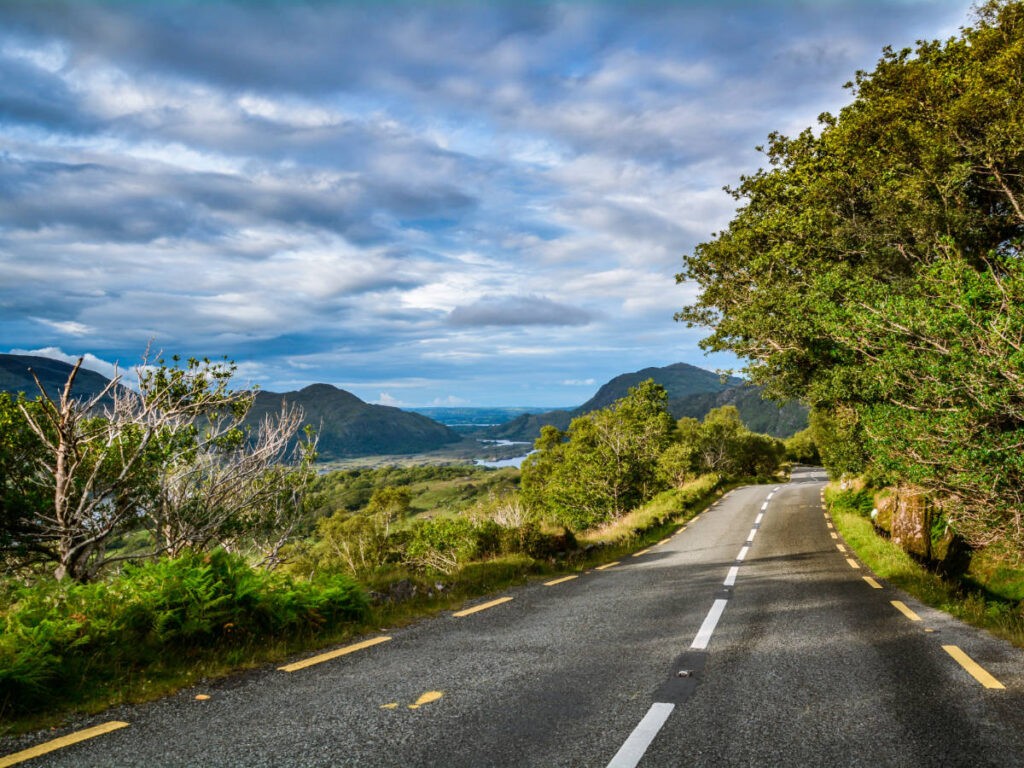 A scenic view of driving through the Irish countryside
A scenic view of driving through the Irish countryside
5. Ideal Trip Length: Making the Most of Your Time
Determining the ideal trip length depends on your interests and budget. However, a week is generally considered a good starting point for exploring Ireland’s highlights.
- 7-Day Itinerary: A week allows you to visit key attractions such as Dublin, the Cliffs of Moher, Galway, and the Ring of Kerry.
- Extended Stay: If you have more time, consider spending 10-14 days to explore more regions, such as Northern Ireland, the Dingle Peninsula, and Connemara.
- Weekend Getaway: A shorter trip of 3-4 days can be focused on a specific region, such as Dublin or the Wild Atlantic Way.
- Custom Itineraries: TRAVELS.EDU.VN offers custom itinerary planning services to help you make the most of your time in Ireland. We’ll tailor your trip to your interests and preferences.
6. Beyond Dublin: Discovering Ireland’s Diverse Regions
While Dublin is a must-see destination, it’s essential to venture beyond the capital to experience the true essence of Ireland. Each region offers unique landscapes, cultural experiences, and attractions.
- Dublin: The vibrant capital city, known for its historical sites, lively pubs, and cultural attractions. Explore Trinity College, Guinness Storehouse, and Temple Bar.
- Galway: A charming city on the west coast, known for its traditional music, arts scene, and access to the Aran Islands.
- Cork: A vibrant city in the south, known for its food scene, historical sites, and proximity to the scenic coastline.
- Ring of Kerry: A breathtaking coastal drive in County Kerry, offering stunning views of the Atlantic Ocean, mountains, and charming villages.
- Cliffs of Moher: Majestic cliffs along the Atlantic coast in County Clare, offering dramatic views and hiking trails.
- Connemara: A rugged and beautiful region in County Galway, known for its wild landscapes, traditional culture, and Gaelic language.
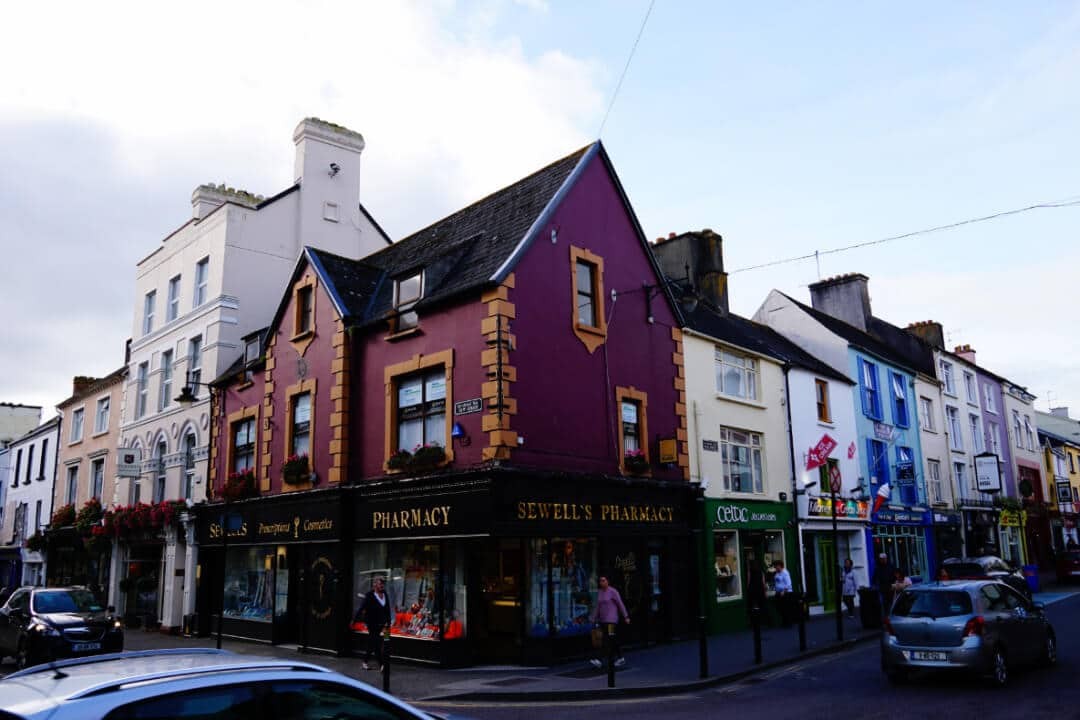 Buildings in Killarney offering a view of destinations outside Dublin
Buildings in Killarney offering a view of destinations outside Dublin
7. Embracing “Craic”: The Spirit of Irish Sociability
“Craic” (pronounced “crack”) is an Irish term that refers to fun, entertainment, and good times. It’s an integral part of Irish culture, and you’ll likely encounter it in pubs, social gatherings, and everyday conversations.
- Pub Culture: Pubs are the heart of Irish social life, offering a welcoming atmosphere, live music, and lively conversations.
- Friendly Locals: The Irish are known for their warmth, hospitality, and sense of humor. Don’t be afraid to strike up a conversation with locals and learn about their culture.
- Music and Storytelling: Traditional Irish music and storytelling are integral parts of the “craic.” Attend a traditional music session in a pub for an authentic cultural experience.
- Open-Mindedness: Embrace the spontaneity and unpredictability of the “craic.” Be open to new experiences and meeting new people.
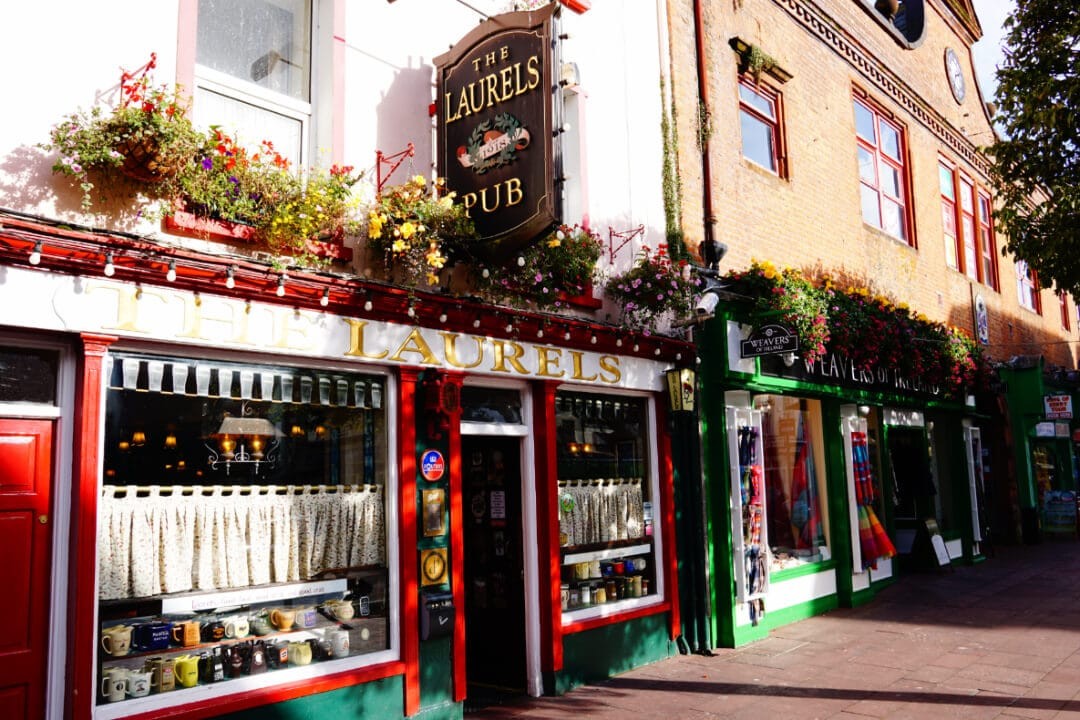 Enjoying the Craic at a pub in Killarney
Enjoying the Craic at a pub in Killarney
8. Beyond Guinness: Exploring Ireland’s Stout Culture
Guinness is synonymous with Ireland, but it’s not the only stout worth trying. Murphy’s Irish Stout is another popular option, particularly in its home city of Cork.
- Guinness: A dry stout with a distinctive dark color and creamy head, brewed in Dublin since 1759. Visit the Guinness Storehouse to learn about its history and brewing process.
- Murphy’s: A smooth and creamy stout with a slightly sweeter flavor than Guinness, brewed in Cork since 1856.
- Other Stouts: Explore other local stouts and craft beers in pubs throughout Ireland. Ask the bartender for recommendations.
- Stout Pairings: Pair your stout with traditional Irish dishes such as Irish stew, seafood chowder, or chocolate desserts.
 A pint of Guinness beer
A pint of Guinness beer
9. Cliffs of Moher: Planning Your Visit Strategically
The Cliffs of Moher are one of Ireland’s most popular attractions, offering breathtaking views of the Atlantic Ocean. To make the most of your visit, plan ahead and consider visiting early in the morning.
- Early Arrival: Arrive at the Cliffs of Moher as early as possible, ideally when they open at 8 am, to avoid the crowds.
- Weather Conditions: Check the weather forecast before your visit and dress accordingly. The cliffs can be exposed to strong winds and rain.
- Walking Trails: Explore the walking trails along the cliffs for different perspectives and photo opportunities.
- Visitor Center: Visit the visitor center to learn about the geology, history, and ecology of the cliffs.
- Alternative Options: If you prefer to avoid the crowds, consider visiting other scenic coastal locations such as the Dingle Peninsula or the Slieve League cliffs.
 Taking photos of the Cliffs of Moher
Taking photos of the Cliffs of Moher
10. Tipping Etiquette: Navigating Irish Hospitality
Tipping is not as prevalent in Ireland as in the United States, but it’s still customary to tip for good service in certain situations.
- Restaurants and Pubs: A tip of 10-15% is customary for good service in restaurants and pubs, especially for sit-down meals.
- Taxis: Tipping taxi drivers is not mandatory, but it’s customary to round up the fare or offer a small tip for good service.
- Hotels: Tipping hotel staff, such as porters or housekeeping, is not expected but is appreciated for exceptional service.
- Tour Guides: Tipping tour guides is customary for informative and engaging tours.
- Service Charges: Check your bill for service charges, which may already be included, especially for large groups.
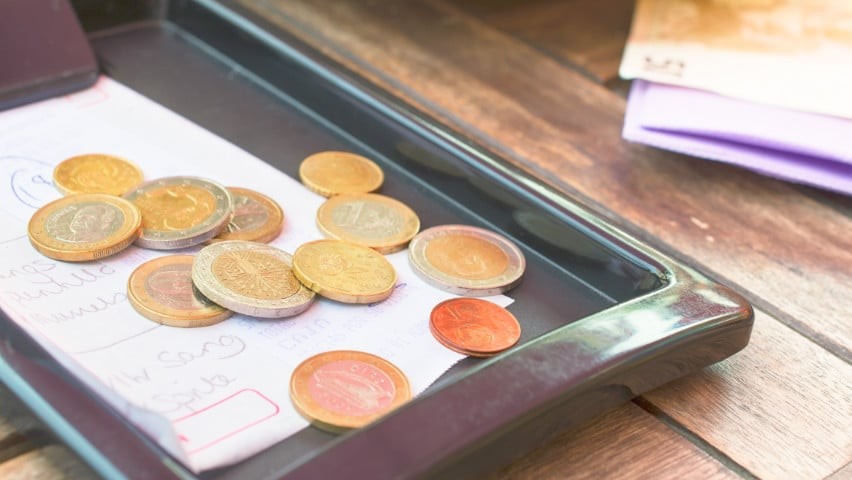 Euro coins and a check
Euro coins and a check
11. Seasonal Tourism: Planning for Peak and Off-Peak Travel
Tourism in Ireland is highly seasonal, with peak season occurring during the summer months (July and August). Consider visiting during shoulder season (April, May, June, September, or October) for lower prices and fewer crowds.
- Peak Season (July-August): Expect higher prices, larger crowds, and the need to book accommodations and tours well in advance.
- Shoulder Season (April-June, September-October): Offers a balance of good weather, fewer crowds, and lower prices.
- Off-Season (November-March): Some attractions may have limited hours or be closed during the winter months. However, you’ll find the lowest prices and the fewest crowds.
- Festivals and Events: Consider planning your trip around festivals and events, such as St. Patrick’s Day, the Galway Arts Festival, or the Dublin Theatre Festival.
12. Airport Options: Exploring Ireland’s International Gateways
Ireland has five international airports: Dublin Airport, Cork Airport, Shannon Airport, Knock Airport, and Belfast Airport. Consider flying into alternative airports for cheaper flights or more convenient access to specific regions.
- Dublin Airport (DUB): The largest and busiest airport in Ireland, serving numerous international destinations.
- Cork Airport (ORK): Located in the south of Ireland, serving destinations in Europe and North America.
- Shannon Airport (SNN): Located in the west of Ireland, offering direct flights to North America.
- Knock Airport (NOC): Located in the northwest of Ireland, serving destinations in Europe.
- Belfast Airport (BFS): Located in Northern Ireland, serving destinations in Europe and North America.
- Flight Comparison: Use flight comparison websites to compare prices and routes from different airports.
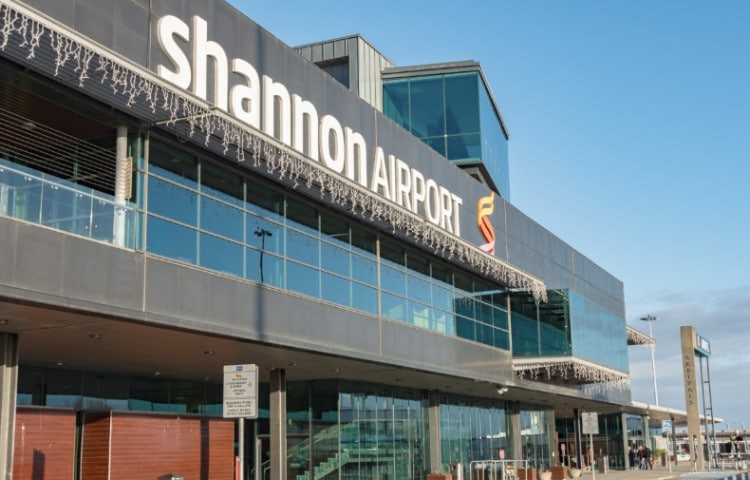 Outside of the Shannon Airport
Outside of the Shannon Airport
13. Budget-Friendly Travel: Exploring Ireland Affordably
Ireland can be an affordable destination with some planning and budgeting. Consider these tips for traveling on a budget:
- Accommodation: Stay in hostels, guesthouses, or Airbnb accommodations to save money on lodging.
- Transportation: Use public transportation, such as buses and trains, to get around. Consider purchasing a travel pass for unlimited travel.
- Food: Cook your own meals or eat at budget-friendly restaurants and pubs. Look for lunch specials and early bird menus.
- Free Activities: Take advantage of free activities such as hiking, visiting parks, and exploring historical sites.
- Travel Deals: Look for travel deals and discounts on accommodations, tours, and activities. TRAVELS.EDU.VN can help you find the best deals for your trip.
14. Travel Insurance: Protecting Your Irish Adventure
Travel insurance is essential for protecting yourself against unexpected events such as illness, injury, or travel disruptions.
- Coverage: Ensure your travel insurance policy covers medical expenses, trip cancellation, lost luggage, and other potential risks.
- Pre-Existing Conditions: Disclose any pre-existing medical conditions to your insurance provider to ensure you’re adequately covered.
- Emergency Assistance: Choose a policy that provides 24/7 emergency assistance and support.
- Policy Comparison: Compare different travel insurance policies to find the best coverage at the best price.
- Peace of Mind: Travel insurance provides peace of mind knowing you’re protected against unexpected events.
15. Driving on the Left: Adjusting to Irish Roads
Driving on the left side of the road can be challenging for drivers accustomed to driving on the right. Take your time, be cautious, and familiarize yourself with Irish road rules.
- Rental Car Familiarization: Take some time to familiarize yourself with the rental car’s controls and features before driving.
- Roundabouts: Pay attention to the direction of traffic in roundabouts and yield to vehicles approaching from the right.
- Lane Positioning: Stay in the left lane unless overtaking. Use your mirrors and signals to ensure safe lane changes.
- Speed Limits: Be aware of speed limits, which are typically posted in kilometers per hour (km/h).
- Defensive Driving: Practice defensive driving techniques and be prepared for unexpected situations.
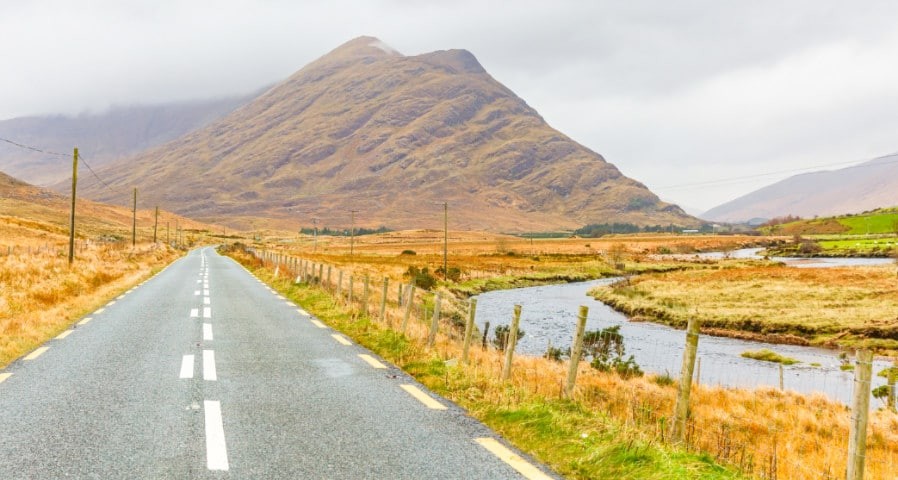 A road in Connemara showcasing driving on the left side
A road in Connemara showcasing driving on the left side
16. Crossing the Street: Look to Your Right
As a corollary to driving on the left, remember to look to your right when crossing the street in Ireland. This can be challenging for visitors from countries where traffic drives on the right.
- Pedestrian Crossings: Use designated pedestrian crossings whenever possible.
- Traffic Signals: Pay attention to traffic signals and wait for the green light before crossing.
- Awareness: Be aware of your surroundings and watch for oncoming traffic.
- Reminder: Remind yourself to look to the right before crossing the street, especially in busy areas.
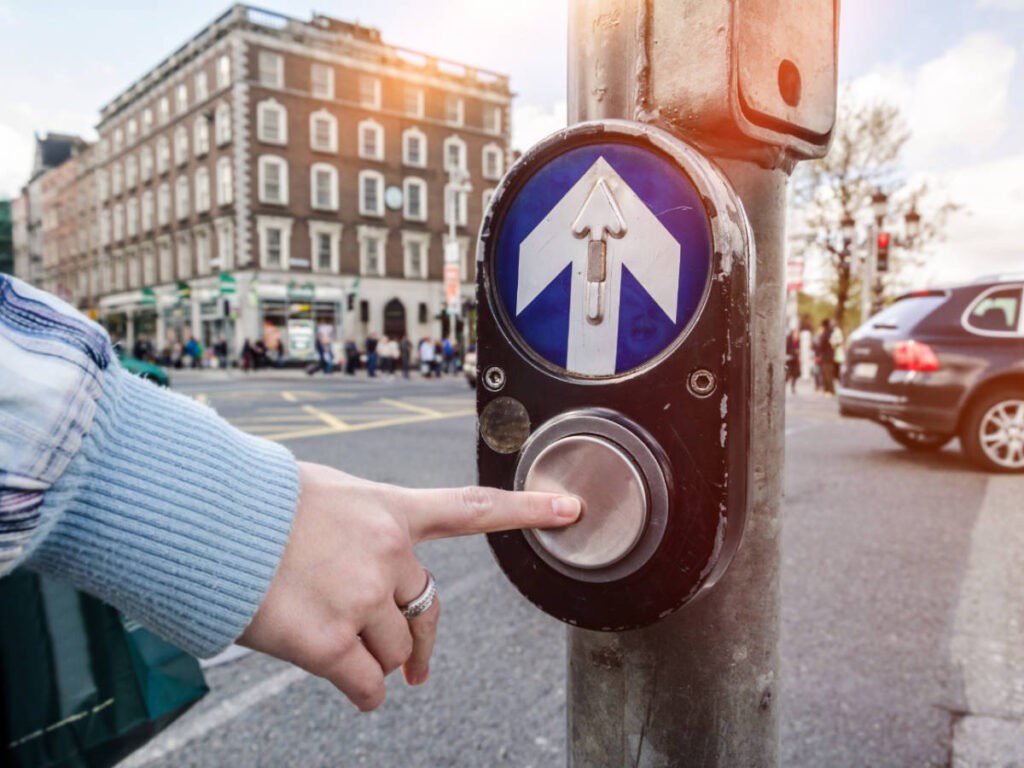 A woman crossing the street in Ireland
A woman crossing the street in Ireland
17. Irish Language: Embracing Gaelic Culture
English is the primary language spoken in Ireland, but Gaelic (also known as Irish) is also an official language. You may encounter Gaelic signage and hear Gaelic spoken in certain regions, particularly in the Gaeltacht (Irish-speaking) areas.
- Gaelic Signage: Be aware of Gaelic signage on roads and in public places.
- Basic Phrases: Learn a few basic Gaelic phrases, such as “Dia dhuit” (hello) and “Go raibh maith agat” (thank you).
- Cultural Significance: Respect the Gaelic language and culture as an integral part of Irish heritage.
- Gaeltacht Regions: Visit the Gaeltacht regions to experience traditional Irish culture and hear Gaelic spoken.
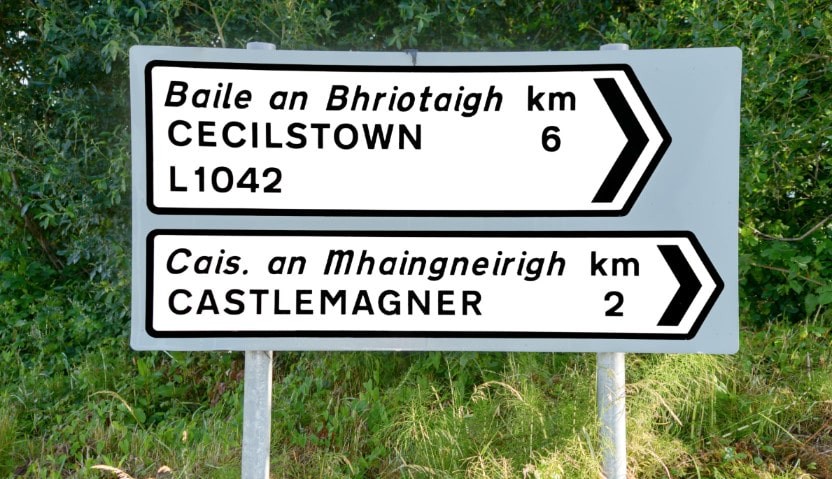 Irish road sign in English and Gaelic
Irish road sign in English and Gaelic
Ready to Experience the Magic of Ireland?
Planning a trip to Ireland can be overwhelming, but with the right preparation, you can create an unforgettable experience. At TRAVELS.EDU.VN, we’re dedicated to providing you with the information and resources you need to plan your dream Irish adventure.
Why Choose TRAVELS.EDU.VN for Your Ireland Trip?
- Expert Knowledge: Our team of travel experts has extensive knowledge of Ireland and can provide personalized recommendations based on your interests and budget.
- Custom Itineraries: We offer custom itinerary planning services to tailor your trip to your specific needs and preferences.
- Exclusive Deals: We partner with top hotels, tour operators, and car rental companies to offer exclusive deals and discounts.
- 24/7 Support: We provide 24/7 support to ensure your trip is seamless and stress-free.
- Unforgettable Experiences: We’re committed to helping you create unforgettable experiences that will last a lifetime.
Contact Us Today!
Don’t let the complexities of planning an Ireland trip hold you back. Contact TRAVELS.EDU.VN today to start planning your dream adventure.
- Address: 123 Main St, Napa, CA 94559, United States
- WhatsApp: +1 (707) 257-5400
- Website: travels.edu.vn
Let us help you discover the magic of Ireland!
FAQ: Your Questions About Traveling to Ireland Answered
- What is the best time of year to visit Ireland?
- The best time to visit Ireland is during the shoulder season (April-June, September-October) for good weather, fewer crowds, and lower prices.
- Do I need a visa to travel to Ireland?
- Visa requirements depend on your nationality. Check with the Irish embassy or consulate in your country for specific requirements.
- What currency is used in Ireland?
- The Republic of Ireland uses the Euro (€), while Northern Ireland uses the Pound Sterling (£).
- Is it safe to drink tap water in Ireland?
- Yes, tap water is generally safe to drink in Ireland.
- What are some must-see attractions in Ireland?
- Some must-see attractions include Dublin, the Cliffs of Moher, Galway, the Ring of Kerry, and the Giant’s Causeway.
- What is the tipping etiquette in Ireland?
- A tip of 10-15% is customary for good service in restaurants and pubs. Tipping taxi drivers is not mandatory but appreciated.
- What is the best way to get around Ireland?
- Renting a car offers the most flexibility for exploring the countryside. Public transportation, such as buses and trains, is also available.
- What should I pack for a trip to Ireland?
- Pack versatile clothing that can be layered, a waterproof jacket, umbrella, comfortable walking shoes, and essential toiletries.
- What is “craic” and how can I experience it?
- “Craic” refers to fun, entertainment, and good times. Experience it by visiting pubs, attending traditional music sessions, and engaging with locals.
- Is travel insurance necessary for a trip to Ireland?
- Yes, travel insurance is highly recommended to protect yourself against unexpected events such as illness, injury, or travel disruptions.
